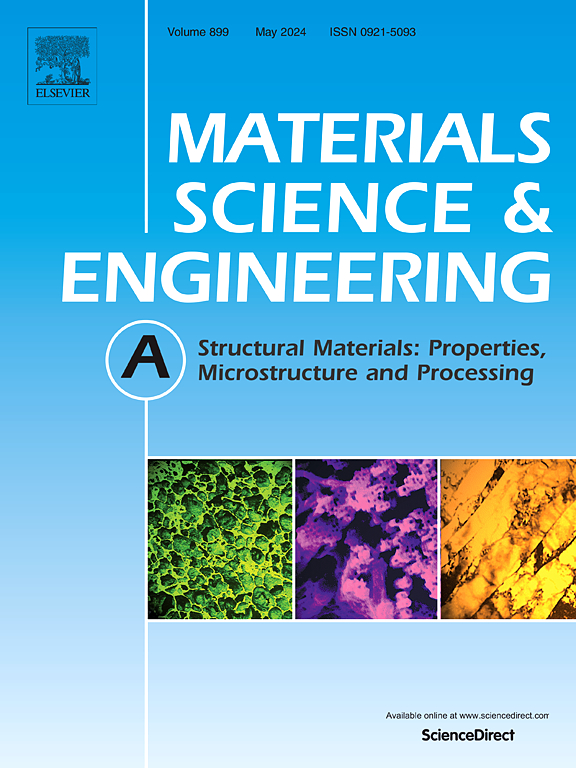难熔NbTiZrM (M = Ta, Mo, V)复合浓缩合金的组织、力学性能和氧化行为
IF 7
2区 材料科学
Q1 MATERIALS SCIENCE, MULTIDISCIPLINARY
引用次数: 0
摘要
在本研究中,我们系统地探讨了Ta、Mo和V对单相体心立方(bcc) NbTiZr合金的组织、力学性能和氧化行为的影响。当Ta或Mo的浓度分别为10%、25%或40% at%时,合金仍保持单相bcc结构,但导致元素偏析,形成富含Ta/Mo的枝晶。在含v合金中,(NbTiZr)90V10和(NbTiZr)75V25合金具有单相bcc结构,而(NbTiZr)60V40合金中形成了两个额外的bcc相,即富Zr和富v相。这些相与富铌bcc基体呈“立方体对立方体”取向关系。Сompression试验表明,Ta和Mo的加入使材料在22 ~ 1000℃的屈服强度呈线性增加。Mo在22 ~ 800℃时的强化效果是Ta的2 ~ 3倍,但在1000℃时却不相上下。在22℃时,V合金的屈服强度线性提高,而在更高温度下,V合金的屈服强度下降。在1000℃下的氧化试验表明,合金元素的作用取决于氧化时间。在短时间内(1 h),最大Ta含量可以消除氧化皮剥落。然而,在较长的时间内,所有添加元素的效果都较差,并伴有氧化皮剥落,含v合金的完全崩解时间最短。通过实验和计算数据的比较,彻底检查了合金的化学成分、结构和性能之间的相关性。本文章由计算机程序翻译,如有差异,请以英文原文为准。
Structure, mechanical properties, and oxidation behaviour of refractory NbTiZrM (M = Ta, Mo, V) complex concentrated alloys
In this study, we systematically explored the effect of Ta, Mo, and V on the structure, mechanical properties, and oxidation behaviour of a single-phase body-centred cubic (bcc) NbTiZr alloy. Alloying with Ta or Mo in concentrations of 10, 25, or 40 at% retained the single-phase bcc structure, yet led to elemental segregations, with the formation of Ta/Mo-rich dendrites. Among the V-containing alloys, the (NbTiZr)90V10 and (NbTiZr)75V25 alloys possessed the single-phase bcc structure, while, in the (NbTiZr)60V40 alloy, two extra bcc phases, namely Zr- and V-rich ones, were formed. These phases adopted a “cube-on-cube” orientation relationship with the Nb-rich bcc matrix. Сompression tests showed that the additions of Ta and Mo increased the yield strength at 22–1000 °C linearly. The strengthening effect of Mo at 22–800 °C was two-to-three times higher than that of Ta, yet it became comparable at 1000 °C. Alloying with V also increased the yield strength at 22 °C linearly, while it degraded the strength at higher temperatures. Oxidation tests at 1000 °C revealed that the effect of alloying elements was dependent on the oxidation time. At a short period (1 h), the maximum content of Ta could eliminate the oxide scale spallation. For longer durations, however, all the elements added had an inferior effect accompanied by the oxide scale spallation, with the shortest time to complete disintegration demonstrated by the V-containing alloys. The correlations between the chemical composition, structure, and properties of the alloys were thoroughly examined through a comparison of experimental and computational data.
求助全文
通过发布文献求助,成功后即可免费获取论文全文。
去求助
来源期刊

Materials Science and Engineering: A
工程技术-材料科学:综合
CiteScore
11.50
自引率
15.60%
发文量
1811
审稿时长
31 days
期刊介绍:
Materials Science and Engineering A provides an international medium for the publication of theoretical and experimental studies related to the load-bearing capacity of materials as influenced by their basic properties, processing history, microstructure and operating environment. Appropriate submissions to Materials Science and Engineering A should include scientific and/or engineering factors which affect the microstructure - strength relationships of materials and report the changes to mechanical behavior.
 求助内容:
求助内容: 应助结果提醒方式:
应助结果提醒方式:


